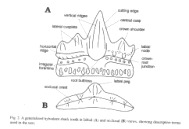|
|
useful terminology from:
Rees, J. 1998. Early Jurassic selachians
from the Hasle Formation on Bornholm,
Denmark. Acta Palaeontological Polonica 43,
3, 439-452.
** * * * * * * * *
Rodrigo SOLER-GIJON, Paläontologisch-
Geologisches Institut und Museum, für
Naturkunde der Humboldt-Universität,
Invalidenstr. 43, D-10115 Berlin, GERMANY
Paper of note:
Soler-Gijon, R. & Lopez-Martinez, N. 1998.
Sharks and rays (chondrichthyes) from the
Upper Cretaceous red beds of the south-
central Pyrenees (Lleida, Spain): indices of
an India-Eurasia connection. Palaeogeog.,
Palaeoclimatol., Palaeoecol. 141, 1-12.
***************************
Charles UNDERWOOD, Department of Earth
Sciences, University of Liverpool, Brownlow
St, Liverpool L69 3BX, UK
E-mail: cju@liv.ac.uk
Underwood, C.J. and Mitchell, S.F. 1999.
Albian and Cenomanian (Cretaceous)
selachian assemblages from north-east
England. Special Papers in Palaeontology,
60:9-56, 9pls.
Underwood, C.J., Mitchell, S.F. and Veltkamp,
C.J. 1999. Microborings in mid-Cretaceous
fish teeth. Proceedings of the
Yorkshire Geological Society, 52(3):269-274.
Underwood, C.J., Mitchell, S.F. and Veltkamp,
K.J. 1999. Shark and ray teeth from the
Hauterivivan (Lower Cretaceous) of north-
east England. Palaeontology, 42(2):287-
302, 2pls.
*****************
Another paper of interest:
Borsuk-Bialynicka, M., Cook, E., Evans,
S.E., &Marya_ska, T. 1999. A
microvertebrate assemblage from the Early
Triassic of Poland. Acta Palaeontologica
Polonica44(2):167-188.
|
|
|
|
|
|
|
In 1938, the first living coelacanth (Latimeria
chalumnae) was caught off the east coast of
South Africa. This major discovery revealed
the existence of a "living fossil" thought to
have become extinct 70ma and whose
morphology had evolved very little since it
appeared in the Devonian, over 400ma.
About 200 other coelacanths recorded since
the late 1930s have mostly been fished off
the Comoros.
To date, all scientific investigation on the
rare specimens found since have confirmed
the assumption that the population of L.
chalumnaewas restricted to the Mozambique
Strait or even to just one or two of the
Comoros islands (Grand Comoros and
Anjouan). This long-held hypothesis was
shaken with the discovery in July 1998 of a
coelacanth more than 9000 km away, near
Menadotua Island in the Celebes archipelago
of Indonesia (see Geoscientist v8, 12, p18).
Like the original specimen of L.chalumnae,
the new specimen was found accidentally in a
fish-market.
To find out if the Indonesian and Comoros
coelacanths belong to distinct populations, a
joint research team from IRD, Institut de
rescherche pour le développement, LIPI
(Division of Zoology Research and
Development Centre for Biology, Indonesia)
and CRIFI-RIFF (Central Research Institute
for Fisheries, Indoniesia) have performed
genetic sequence analysis and established a
morphological description of the new
specimen. The Indonesian specimens show
significant genetic and morphological
differences fromL. chalumnae, which
normally shows very little morphological
variation. The genetic differentiation is at a
|
|


 1
2
3
4
5
6
7
8
9
10
11
12
13
14
15
16
17
18
19
20
21
22
23
24
25
26
27
28
29
30
31
32
33
34
35
36
37
38
39
40
41
42
43
44
45
46
47
48
1
2
3
4
5
6
7
8
9
10
11
12
13
14
15
16
17
18
19
20
21
22
23
24
25
26
27
28
29
30
31
32
33
34
35
36
37
38
39
40
41
42
43
44
45
46
47
48



 1
2
3
4
5
6
7
8
9
10
11
12
13
14
15
16
17
18
19
20
21
22
23
24
25
26
27
28
29
30
31
32
33
34
35
36
37
38
39
40
41
42
43
44
45
46
47
48
1
2
3
4
5
6
7
8
9
10
11
12
13
14
15
16
17
18
19
20
21
22
23
24
25
26
27
28
29
30
31
32
33
34
35
36
37
38
39
40
41
42
43
44
45
46
47
48

